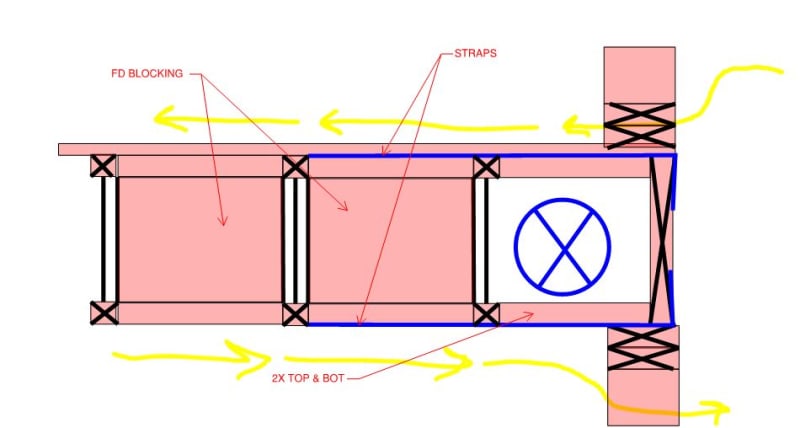I've always detailed blocking within the floor cavity, when the joists run parallel to an exterior wall, as full height. However, I have a builder that would like to install a partial height block at the top of the wall to allow ducting to run through the floor cavity. From my understanding the block needs to be nailed to the sheathing to transfer the OOP loads to the diaphragm. Is there any situation where that isn't necessary and only providing a block at the bottom (and maybe the top) of the cavity is okay, with a hollow center?
Navigation
Install the app
How to install the app on iOS
Follow along with the video below to see how to install our site as a web app on your home screen.
Note: This feature may not be available in some browsers.
More options
Style variation
-
Congratulations TugboatEng on being selected by the Eng-Tips community for having the most helpful posts in the forums last week. Way to Go!
You are using an out of date browser. It may not display this or other websites correctly.
You should upgrade or use an alternative browser.
You should upgrade or use an alternative browser.
Blocking in Floor Cavity for OOP Bracing - Full Height?
- Thread starter Ambemily
- Start date
- Status
- Not open for further replies.
For the TLA averse, I suspect that OOP = Out of Plane.
Unless you're willing to use the ceiling as a diagram, I believe that you'll have to bring the loads up to the floor sheathing plane eventually. Something like I've shown below could garner you some duct space in any particular cavity but I've got a hunch that your builder will object to the cost & complexity. That's her problem though. I'd toss something like this on the table to show how creative and flexible I am and then let them pick from the available options.

Unless you're willing to use the ceiling as a diagram, I believe that you'll have to bring the loads up to the floor sheathing plane eventually. Something like I've shown below could garner you some duct space in any particular cavity but I've got a hunch that your builder will object to the cost & complexity. That's her problem though. I'd toss something like this on the table to show how creative and flexible I am and then let them pick from the available options.

Yes OOP = out of plane (where i come from).
How about a half baked compromise. Assuming you're using I-joists, would builder entertain the idea of using joist blocking with a hole sawed in the middle of the web? That way you have (at least some) in-plane shear capacity of the blocking. Guess it depends on how big the duct is. That way it would be a huge pain for the mechanical guy too!
How about a half baked compromise. Assuming you're using I-joists, would builder entertain the idea of using joist blocking with a hole sawed in the middle of the web? That way you have (at least some) in-plane shear capacity of the blocking. Guess it depends on how big the duct is. That way it would be a huge pain for the mechanical guy too!
I'd get crucified if I showed straps. At the main floor I feel they're unnecessary, at the upper floors I feel the demand is likely low enough that toe nails in each end of the blocks is potentially enough considering I put blocking at 24" on-centre. Then again, I'm half builder minded and half engineer minded. Many times I think something is overkill, until I run the numbers.
I still think you could omit the upper strap because the sheathing would provide enough tensile connection, I could see the need for the bottom strap, but getting them to install it would be unlikely.
I still think you could omit the upper strap because the sheathing would provide enough tensile connection, I could see the need for the bottom strap, but getting them to install it would be unlikely.
jayrod12 said:At the main floor I feel they're unnecessary, at the upper floors I feel the demand is likely low enough that toe nails in each end of the blocks is potentially enough considering I put blocking at 24" on-centre.
Curious, what makes you say that? I would have expected the demand to be at it's maximum at the main floor.
I'd not meant for anybody to get hung up on what straps go where or even if straps are required. My intent was simply to convey the general concept of the load path and to leave the particulars to the designer running the numbers / negotiating with the contractor. Toe nails up front and twist straps to bridge the joists would be one of many possible options.
The blocking is required at the main floor 100%. I just dont see the need for any tension connection as the blocking will always be in compression.
I can see the need for a tension connection between the top of wall and the blocking at the second floor with wind suction.
I can see the need for a tension connection between the top of wall and the blocking at the second floor with wind suction.
- Status
- Not open for further replies.
Similar threads
- Locked
- Question
- Replies
- 5
- Views
- 2K
- Replies
- 2
- Views
- 2K
- Locked
- Question
- Replies
- 4
- Views
- 3K
- Locked
- Question
- Replies
- 3
- Views
- 968
- Replies
- 6
- Views
- 3K
